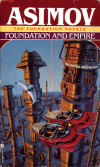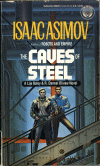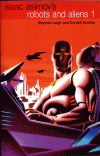My favorite science fiction writer by far is Isaac Asimov (1920-1992). One of the main reasons I started this website was to document my re-reading of his Robot and Foundation books. I recount my introduction to his writing in my post celebrating his 90th birthday. There I mention starting to read his autobiography. That actually was the first volume, In Memory Yet Green (1970) covering his life from 1920-1954. It was an out of print low quality hard back copy. I still have that volume, but for some reason I never got around to finishing it. My last bookmarked page was 167 of 708. His next volume was In Joy Still Felt (1980) covering his life from 1954-1978. I fully intended on reading both of those, then finally his third volume (for this review) I, Asimov: A Memoir (1992).
Since my post in 2010, I’ve shifted almost all of my reading to ebook formats. Unfortunately I could not find any of the old volumes on ebook. My physical copy of In Memory Yet Green sat on the shelf collecting dust, literally! Sometime last year there was a sale on this book on the Google Play Store for just a buck or two. I snatched it up immediately and put it on my short list to read after finishing John Scalzi’s Old Man’s War series which I was in the middle of at the time.
For a while I was frozen with indecision. Should I dig harder and try to find the first two volumes in ebook format? Drudge through the physical copy I had and then find the out of print second volume? Luckily I checked out some of the reviews. This third volume isn’t just 1978-(present at time of publish), but covers his entire life. The format is also not strictly chronological, but jumps from subject to subject. I was hesitant at first, partially from having a tendency to want to read things chronologically, even if they are published out of order (see my reading project). The more I thought about it, the closer I came to realizing it didn’t matter! I could read the third volume, then go back and read the first two, and maybe the third again! There is actually a 4th autobiography, It’s Been a Good Life (2002) that was edited after his death by his second wife Janet Jeppson Asimov. I plan on reading as well, possibly before the first two volumes.
If you are at all interested in Isaac Asimov, or science fiction in general, you must read this book. Having already had a false start on In Memory Yet Green, I can say I enjoyed this format better. Most “chapters,” which I will call topics, are at most five to ten pages in length. This makes for easy stopping points. I found myself reading many topics throughout the day, with several back to back during my lunches, where I normally spend most of my time reading.
This may sound silly, but one of the first things that struck me when starting this book was, “Man, this is easy to read!” It really felt like he was talking to me, something he notes throughout this book as one of his strong points. His writing has a conversational style, which I suspect is normal for an autobiography, but thinking back it was fairly evident in his book Isaac Asimov’s Guide to Earth and Space that I recently listened to on audio. [By the way, that was the worst audiobook recording quality-wise that I’ve ever listened to. Essentially it was a bad transfer of a cassette that probably sat in a hot garage for 10 years. I wish I went for the ebook.] This writing style makes me want to read more of his non-fiction. I actually have Asimov’s Chronology of the World and Extraterrestrial Civilizations in paperback. I haven’t made time to read those, but I plan on squeezing them in sooner rather than later. I’m also curious how he approached textbooks. Unfortunately some that he wrote will likely be severely outdated, but I’d like to at least try one or two.
An unexpected bonus was that Asimov recounts his interactions with probably every major science fiction author you can think of from the “Golden Age”. He also lists some that he admired that I’m sure 99% of sci-fi fans have never heard of. Thanks to Asimov, I now have more than a handful of old authors to check out whenever I can find the time. In most cases he is humble in his comparison of his fiction writing to these other authors. It is surprising, since I know he’s famous for being full of himself in most regards.
One of most famous stories stories related to this is the Clarke-Asimov Treaty, where they both agree that Clarke is the best science fiction writer, and Asimov is the best science writer. When I first discovered Asimov, I had no idea that his science fiction was just a small percentage of his overall body of work. In this memoir, he seemed almost resentful of Doubleday (his long time publisher) for practically forcing him back into writing science fiction novels after a 20 year hiatus. Personally, I’m glad they badgered him back into it, because it led him to merge the Robot and Foundation series’ together, and expanded on my favorite character of all time, R. Daneel Olivaw. Aside from Clarke, Asimov lists many other science fiction authors he thought were better than himself, but the two that stick out most are Harlan Ellison and Robert Silverberg. I’ve only read Ellison’s I, Robot: The Illustrated Screenplay, but I’ll probably check out some of his other work. I have read all of Silverberg’s collaborations with Asimov: The Ugly Little Boy, The Positronic Man, and Nightfall.
Toward the end of the book, Asimov tackles the topic of his failing health. At the time he only wrote of his kidneys failing, but the true cause of his death was revealed later by Janet Asimov in It’s Been a Good Life (2002) as being a complication of HIV contracted from a blood transfusion during his triple bypass operation in 1983. For this book however, the true cause was left hidden. I found myself starting to get both choked up and angry at the same time as I neared the end of his final section “New Life” where he begins to list people in his life dying ahead of him, coming to grips with sickness, and expectation of imminent death. It is such a shame that such a great man was taken from the world way too early in a way that could have been prevented. Janet Asimov wrote a touching epilogue that described what happened following the short time between the finalization of this manuscript and Asimov’s death.
I must stress again that the format of this autobiography is far superior than that of Isaac Asimov’s first two volumes. While the overall treatment is chronological, I think you could just grab any section (as I refer to chapters), and have a quick 5 minute pleasurable read. Once you finish this one up, you could revisit the older volumes to fill in as Asimov might say the “mundane details” of his life. If you are a fan of Asimov, you owe it to yourself to grab a copy in whatever format you prefer and start chugging away. It is quite long, but at no point was I thinking that I just wanted to get to the end. The opposite, however, is true. I didn’t want it to end. Luckily though there are at least 3 other volumes I can turn to.



Excellent review. Picking up a copy